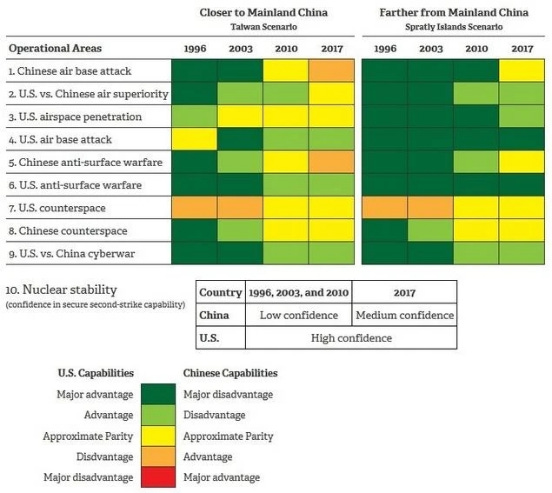Subvert Your Understanding of China-U.S. Relations--Part 1
Are China-U.S. relations truly unsolvable?
In international affairs, the criteria for judging truth are not democracy versus authoritarianism, right versus wrong, good versus evil, true versus false, or beautiful versus ugly, but rather 'wise' versus 'silly.' What is 'wise' ? It is understanding the objective, achieving it with the best cost-effectiveness, minimal negative impact, and to the greatest extent possible. That is 'wise' .
What is 'silly'? It is not having a clear understanding of one's fundamental objectives, wasting countless human and material resources on inexplicable actions, and ultimately achieving disastrous results while still believing oneself to be righteous. That is 'silly'.
1. Unsolvable Problem
Nowadays, China-U.S. relations are becoming an increasingly prominent focal point and hot topic. The reason is quite simple: the relative decline of the United States' position leads it to believe that China will soon surpass it, causing great anxiety about losing its status as the world's dominant power. Trump's trade war and tech war against China are a concentrated outbreak of this American anxiety. Currently, China's diplomatic tone towards the United States is also becoming increasingly unyielding. From the Anchorage to Tianjin diplomatic dialogues, in response to the consistent domineering attitude of the United States, the Chinese side is speaking more openly and straightforwardly. Besides large-scale trade and tech wars, the United States is also adopting increasingly provocative and even purely 'nuisance' tactics towards China.
Imposing sanctions on Xinjiang cotton under the pretext of 'forced labor' and 'genocide.' Continuously asserting 'freedom of navigation' in the South China Sea and Taiwan Strait. Repeatedly provoking China’s bottom line on the Taiwan issue with high-level officials visiting Taiwan,transport planes landing in Taiwan and providing weapons to Taiwan,sanctioning Chinese personnel and interfering in Hong Kong affairs.
Of course, these issues are not the only challenges in China-U.S. relations; they are simply the most urgent ones that need to be addressed to normalize the relationship. Many experts on China-U.S. relations generally believe that the relationship is "unsolvable." This stems from the fact that China cannot halt its own development merely to "accommodate" the United States' hegemonic position.
The overall strength of China and the U.S. is already quite comparable, and as China continues to grow, it is inevitable that the U.S. will lose its hegemonic status. However, the American elite stubbornly insists that the United States must not give up its position of global hegemony and is desperately seeking strategies to contain China's growth. Yet the reality is becoming increasingly apparent: the United States is finding it progressively harder to restrain China.
Therefore, this conflict seems insurmountable. The methods the United States employs to contain China can be summarized as follows:
1) military containment;
2) trade and tech war
3) nuisance tactics.
2.Military Containment
Employing actual military means to contain China and disrupt its modernization process has become virtually impossible. In 2016, the RAND Corporation released a report titled "War with China—Thinking Through the Unthinkable," which indicated that the strategic window for containing China would remain open until 2020. Now that it's 2024, that window has closed. A comparison of military capabilities between China and the United States clearly shows that the U.S. lacks the capacity to engage in a war with China.
U.S. military-related agencies conduct annual simulations of a conflict between China and the United States in the Western Pacific, and the outcomes increasingly indicate a "devastating defeat" for the U.S. military. Even attaining a "pyrrhic victory" would necessitate the use of hypothetical weapons that do not exist in reality.
In terms of actual military strength, even in the early days following its establishment, China had already shown that the United States lacked the capability to wage war against it and come out victorious. This is not based on theoretical studies or war simulations, but on the outcomes of real-world conflicts. From October 1950 to July 1953, the two countries directly engaged in the Korean War, with the United States fighting alongside 16 other countries (including South Korea). They also engaged indirectly in the Vietnam War and had direct aerial contest over the South China Sea(Especially in recent years, electronic information warfare has become more frequent).
The outcomes of actual military confrontations have consistently demonstrated that the United States cannot win against China and has, in fact, been deterred by these encounters. During certain strategic windows in recent decades, the United States did have the opportunity to gain significant advantages over China through military means, particularly during the period of the Gulf War.
The outcome of the Gulf War made China break out in a cold sweat. Had a conflict erupted between China and the United States at that time, China could have faced significant setbacks in a conventional war. Back then, the United States could have deployed just two carrier strike groups to potentially inflict devastating damage on China's naval and air forces in the Western Pacific. Even Taiwan's naval and air power at the time could have posed a serious challenge to mainland China's military. However, that brief window of vulnerability has long since closed. The Gulf War served as a wake-up call for China, prompting an immediate and effective modernization of its military forces. Fortunately for china, at that time, China and the United States were still in the honeymoon phase of their alliance against the Soviet Union. Yes, you didn't misread that; they did have a honeymoon.
Even during that period, while the United States could have gained significant advantages through conventional military means, it does not mean it would have achieved a decisive victory. Just look at the current situation: its military campaigns in Iraq and Afghanistan have resulted in prolonged struggles. How could it then expect to successfully confront China? Moreover, China is not Iraq. Since the mid-1960s, China has possessed nuclear and missile weapons. By the time of the Gulf War, China had developed nuclear submarines and DF-5 ballistic missiles, which had the capability to effectively deter most parts of the U.S. mainland.
Iraq did not have weapons of mass destruction, but China truly does.
Moreover, China was well aware at that time that engaging the United States with conventional naval and air forces alone would not yield favorable results. Asymmetric retaliation using ballistic missiles and other means was a certainty. The influential book "Unrestricted Warfare," published in 1999, is a testament to this era. It systematically outlined China's strategic thinking on how its military intended to counter overwhelming pressure through asymmetric warfare.
Therefore, it's not as simple as claiming that the U.S. military could unilaterally decimate China's naval and air forces. The option of the United States directly using military means to contain mainland China has been unfeasible since October 1949, not just after some so-called strategic window period in the 21st century.
Therefore, more accurately, it’s not that the window for the U.S. to militarily contain China has passed, but rather that the "fantasy window" for such containment has closed, leaving only a period of "desperation." It’s not just because China possesses weapons of mass destruction that the U.S. can't engage in conflict; even in terms of conventional military strength, the U.S. no longer holds a decisive advantage. This is why, when some recently called for an increase in China's nuclear arsenal, the military was dismissive. Do we really need weapons of mass destruction to counter the U.S.? Even with smaller-scale weapons, the U.S. would struggle to prevail.
The RAND Corporation's assessments of the evolving military balance between China and the U.S. reinforce this reality. Their studies indicate that China's continuous advancements in military capabilities and strategic deterrence have significantly narrowed the gap, making any straightforward military containment unfeasible for the U.S.
Overall, apart from not yet having a stealth strategic bomber (or not disclosing it), China has already resolved the question of having aircraft carriers. The focus now is on enhancing their quantity and quality. Given China's status as a manufacturing giant, increasing the number of carriers is not a significant issue; if necessary, China could achieve parity with the United States within a decade. Specifically, in the Western Pacific region, having six aircraft carriers could effectively offset the advantage of the United States' 11 carriers.
China's Type 055 destroyers are already more advanced than any U.S. warship except for the DDG-1000 Zumwalt-class destroyers. However, the DDG-1000 Zumwalt-class, with only three ships built, has not yet achieved full combat readiness and is essentially ineffective in the Western Pacific. The J-20, China's mainstay fighter jet, has reached combat readiness, and in the foreseeable future, the Chinese Air Force is expected to gain a comprehensive advantage over the U.S. Air Force. Hypersonic weapons like the DF-17, developed based on Qian Xuesen's ballistic principles, provide China with an overwhelming edge over the United States. Additionally, missiles such as the DF-21D and DF-26 have already neutralized the U.S. naval advantage in the Western Pacific.
This certainly doesn't mean that China's overall military capability has already surpassed that of the United States. The key difference lies in strategy: China adopts a defensive approach, while the U.S. would need to pursue an offensive strategy. To successfully launch an offensive, the attacker typically needs to have a 3 to 5 times advantage in strength over the defender. The United States simply cannot attain such a level of superiority.
Currently, the tonnage of new ships launched by the Chinese Navy each year is roughly equivalent to the combined total of all developed countries. By contrast, the tonnage of new ships launched annually by the U.S. Navy is less than one-third of China's. So what kind of strategic games can the U.S. realistically play? Furthermore, this discrepancy exists even though China's military spending is only about 1.2% of its GDP, compared to the U.S., which maintains its defense budget at around 3.4% to 4% of its GDP. If China truly believed that the U.S. intended to start a war, it could significantly increase its military spending, rapidly achieving parity with the U.S. in terms of the number of main warships and advanced aircraft within a few years.
The issue is that China has not effectively communicated this information to the world, preventing global recognition of the current state of affairs from a position of strength.
3. Trade War and Technology War
In 2017, Steve Bannon, a prominent anti-China figure in Trump's administration, claimed that the window to contain China was only five years (until 2022). He warned that if decisive action was not taken within this period, it would become impossible to contain China afterward. This formed the ideological basis for the Trump administration's comprehensive trade war and technological warfare against China.
However, the comprehensive trade war and technological war that began in March 2018 and continues to today have already persisted for six years. The facts have shown that these measures have been largely ineffective against China and have inflicted greater harm on the United States than any perceived benefits. China's trade surplus with the U.S. has steadily increased during the trade war, and the associated costs have predominantly been shouldered by the United States itself.
The technological conflict has indeed posed some challenges for China, but these are relatively minor and have significantly accelerated China's advancement in core technologies, proving to be far more beneficial than detrimental. Instead of describing the technological conflict as a "harm" to China, it would be more fitting to liken it to "Chinese acupuncture." It may sting a bit, but it has effectively started to unblock the vital pathways for technological innovation in China.
4.Nuisance Tactics
It's now 2024, well past the window period Bannon mentioned, yet is there any hope of containing China? Absolutely not. This is the real challenge the Biden administration, which took office in early 2021, faces: how to handle China effectively? So far, there hasn't been a clear strategy or fundamental approach. Judging by their actions, the de facto strategy seems to be "doing everything possible to irritate China," resulting in a series of misguided and counterproductive measures intended to distract and unsettle China.
The United States increasingly finds itself needing assistance from China, while China emphasizes a dual-circulation strategy, balancing domestic and international development, thus reducing its dependencies on the U.S. In this context, it's impractical and shameless for the U.S. to antagonize China while simultaneously seeking its help. What practical effect does merely irritating China achieve? Besides making it harder for the U.S. to seek assistance, it causes minimal actual harm to China. Conversely, it provides China with more opportunities for significant strategic gains.
For example, each time the U.S. stirs up trouble in the Taiwan Strait, China makes permanent advancements—such as eliminating the median line and normalizing military aircraft and naval patrols around Taiwan. Similarly, when the U.S. encouraged unrest in Hong Kong, it only resulted in the swift implementation of the Hong Kong National Security Law.
Sanctions on Xinjiang cotton have actually highlighted its superior quality to the world. Previously, the bulk of Xinjiang's cotton supply was monopolized by foreign textile companies. Now, Chinese textile firms have access to these supplies. Given that Xinjiang cotton is already in high demand within China, it's hard to see how sanctions could harm the country. Moreover, a closer look at American history reveals that the real perpetrators of forced labor and genocide are primarily in the United States.
The U.S. resorting to nuisance tactics against China highlights its utter lack of basic understanding and strategy in China-American relations. Previously, whether through military actions, trade wars, or technological confrontations, there was at least some foundational judgment, strategy, and clear objectives, regardless of their success. However, these recent actions are mere emotional outbursts, completely devoid of even faulty reasoning or impractical goals. It reflects a state of total irrationality and hysteria.
Mearsheimer has repeatedly criticized the Biden administration for foolishly pushing Russia into China's arms by driving the Ukraine war;The conversation between Kissinger and Kishore Mahbubani before Kissinger's death also expressed the current lack of a clear strategy towards China by the United States, which is quite tragic.
Therefore, only by clearly understanding the current situation and the underlying patterns on both sides can we find the fundamental solutions to these problems.
I will continue in next post.
Please help to forward this post to your friends if you like it, or even you hate it. Waiting your Friendly and unfriendly comments also,The clearer the truth becomes through debate and communication.




